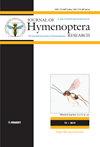欧洲带翅蜂亚属Andrena(膜翅目,Andrenidae)蜜蜂神秘多样性的意外水平:对保护的启示
IF 1.4
3区 农林科学
Q2 ENTOMOLOGY
引用次数: 14
摘要
使用DNA条形码和形态学的组合,我们检查了欧洲带尾蜂亚属Andrena蜜蜂的物种边界。首先,我们解决了围绕Andrena ovatula(Kirby,1802)和A.albofasciata Thomson(1870)的地位的长期争议,它们在近100年前被提出代表不同的物种,但在最近的研究中大多被视为同种。我们的研究结果明确支持了两个常见于同科的分类群的存在:第一个分类群被称为A.ovatula,存在于北欧,但也存在于地中海沿岸的南欧;第二个分类单元被称为A.afzeliella(Kirby,1802),stat.rev.,其中A.albofasciata被认为是初级同义词(syn.nov.),在欧洲广泛分布。第二,我们证明了另一个迄今为止在欧洲被忽视的广泛分布的物种:A.ovata Schenck,1853,stat.rev。第三,我们证明,由于显著的形态和遗传差异,目前被视为亚种的两个分类群应该被赋予特定的等级:A.croceivetris Morawitz,1871,stat.ev.,到目前为止被视为A.similis Smith的亚种,1849,和A.vocifera-Warncke,1975年,stat.nov.,到目前为止被视为A.gelriae van der Vecht的亚种,1927年。A.croceiventris和A.vocifera在欧洲的范围都特别有限,分别只在意大利中部和南部、西西里岛以及法国大陆。第四,我们描述了来自撒丁岛和科西嘉岛的一个新种,a.antonellaesp。最后,提出了以下新的同义词:A.similis,A.ocreata cypisina Warncke,1975和A.similis-caraimica Osytshnjuk,1994与A.russula Lepeletier,1841(syn.nov.)同义;A.fuscata(Kirby,1802)、A.canescens Schenck,1853和A.pseudovatula Alfken,1926与A.afzeliella(syn.nov.)同义。Lectypes被指定为A.afzeriella、A.fuscatta(Kirby(1802))、A.ovata和A.wilkella(Kirby),1802。我们的研究结果表明,这群蜜蜂的多样化速度特别快,导致许多物种的地理范围特别有限。我们讨论了欧洲蜜蜂这种惊人的神秘多样性对保护的影响。本文章由计算机程序翻译,如有差异,请以英文原文为准。
Unexpected levels of cryptic diversity in European bees of the genus Andrena subgenus Taeniandrena (Hymenoptera, Andrenidae): implications for conservation
Using a combination of DNA barcodes and morphology, we examine species boundaries in bees of the genus Andrena subgenus Taeniandrena in Europe. First, we solve the long controversy surrounding the status of Andrena ovatula (Kirby, 1802) and A. albofasciata Thomson, 1870, proposed to represent distinct species nearly 100 years ago, but mostly treated as conspecific in recent studies. Our results unambiguously support the presence of two taxa that are often found in sympatry: the first taxon, referred to as A. ovatula, is present in Northern Europe but also in Southern Europe along the Mediterranean coast; the second taxon is referred to as A. afzeliella (Kirby, 1802), stat. rev., with A. albofasciata considered to be a junior synonym (syn. nov.), and is widely distributed in Europe. Second, we show that another widely distributed species has hitherto been overlooked in Europe: A. ovata Schenck, 1853, stat. rev. Third, we demonstrate that two taxa currently treated as subspecies should be given specific rank due to significant morphological and genetic differences: A. croceiventris Morawitz, 1871, stat. rev., so far treated as a subspecies of A. similis Smith, 1849, and A. vocifera Warncke, 1975, stat. nov., so far treated as a subspecies of A. gelriae van der Vecht, 1927. Both A. croceiventris and A. vocifera have particularly restricted ranges in Europe, being known only from central to southern Italy and Sicily, and continental France, respectively. Fourth, we describe a new species from Sardinia and Corsica, A. antonellaesp. nov. Lastly, the following new synonymies are proposed: A. similis, A. ocreata cyprisina Warncke, 1975 and A. similis caraimica Osytshnjuk, 1994 are placed in synonymy with A. russula Lepeletier, 1841 (syn. nov.); A. fuscata (Kirby, 1802), A. canescens Schenck, 1853 and A. pseudovatula Alfken, 1926 are placed in synonymy with A. afzeliella (syn. nov.). Lectotypes are designated for A. afzeliella, A. fuscata (Kirby, 1802), A. ovata and A. wilkella (Kirby, 1802). Our results suggest a particularly fast diversification in this group of bees, leading to the presence of numerous species exhibiting particularly restricted geographic ranges. We discuss the implications for conservation of this astonishing cryptic diversity in European bees.
求助全文
通过发布文献求助,成功后即可免费获取论文全文。
去求助
来源期刊
CiteScore
2.60
自引率
15.40%
发文量
68
审稿时长
>12 weeks
期刊介绍:
The Journal of Hymenoptera Research is a peer-reviewed, open-access, rapid online journal launched to accelerate research on all aspects of Hymenoptera, including biology, behavior, ecology, systematics, taxonomy, genetics, and morphology.
All published papers can be freely copied, downloaded, printed and distributed at no charge for the reader. Authors are thus encouraged to post the pdf files of published papers on their homepages or elsewhere to expedite distribution. There is no charge for color.

 求助内容:
求助内容: 应助结果提醒方式:
应助结果提醒方式:


